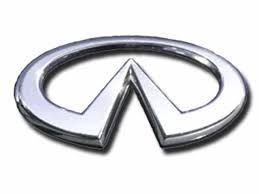FX35 RWD V6-3.5L (VQ35HR) (2010)
/Page-953005.png)
Clean any dust from the brake caliper and brake pads with a vacuum dust collector. Never blow with compressed air.
CAUTION:
-
Never depress the brake pedal while removing the brake pads or the cylinder body because the piston may pop out.
-
Never spill or splash brake fluid on the disc rotor.
1. Remove tires with power tool.
2. Remove the upper sliding pin bolt.
3. Suspend the cylinder body with a wire so that the brake hose will not stretch. Remove the brake pads, shims, shim cover and pad retainers from the
torque member.
CAUTION:
-
Never deform the pad retainers if removing the pad retainers.
-
Never damage the piston boot.
-
Never drop the brake pad, shims, and the shim cover.
-
Remember each position of the removed brake pads.
INSTALLATION
WARNING:
Clean any dust from the brake caliper and brake pads with a vacuum dust collector. Never blow with compressed air.
CAUTION:
-
Never depress the brake pedal while removing the brake pads or the cylinder body because the pis- ton may pop out.
-
Never spill or splash brake fluid on the disc rotor.
1. Apply PBC (Poly Butyl Cuprysil) grease or silicone-based grease to the pad retainers before installing it to the torque member if the pad retainers
has been removed.
CAUTION:
-
Securely assemble the pad retainers so that it will not be lifted up from the torque member.
-
Never deform the pad retainers.
2. Apply PBC (Poly Butyl Cuprysil) grease or silicone-based grease to the mating faces between the shims and the shim cover.
CAUTION:
Always replace the shims together with the shim cover when replacing the brake pad.
3. Apply PBC (Poly Butyl Cuprysil) grease or silicone-based grease to the mating faces between the brake pads and pad retainers and install them to
the brake pads.
4. Install cylinder body and brake pads to torque member.
CAUTION:
-
Never damage the piston boot.
-
When replacing brake pad with new one, check a brake fluid level in the reservoir tank because brake fluid returns to master cylinder
reservoir tank when pressing piston in.
NOTE:
Use a disc brake piston tool to easily press piston.
5. Install the upper sliding pin bolt and tighten it to the specified torque.
6. Depress the brake pedal several times to check that no drag feel is present for the rear disc brake. See: Procedures/Rear Disc Brake/Brake Pad (1
Piston Type).
Exploded View
REAR DISC BRAKE
BRAKE PAD (1 PISTON TYPE) BRAKE PAD (1 PISTON TYPE) : Exploded View
